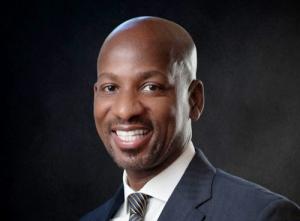Black & Veatch
For Black & Veatch, Martin Travers is Group President, Irvin Bishop is Chief Information Officer, and Brenda Greig is VP-Management Consulting.
It's a popular term these days, innovation is. Organizations like to say they're innovative, as do individuals in our industry. So, the PUF team wanted to sort out, what is it exactly? What makes a company culture innovative?

We figured the leaders at Black & Veatch might have thoughts about this question, a lot, and counseled leaders industry-wide as well. Here's their take on innovation, with Marty Travers, a group president there, taking our questions, flanked by the firm's chief info officer, Irvin Bishop, Jr. and a vice president, Brenda Greig.
PUF's Steve Mitnick: What does innovation in our industry mean to you?
Marty Travers: In engineering and construction, it's finding new ways to impact the way the world lives and operates. Black & Veatch is focused on critical human infrastructure and there are tremendous opportunities through innovation to improve the way people live their lives.
That's what we're focused on, what's new and different that can improve the overall efficiency of the ecosystem of the world people live in.
 Marty Travers: This Growth Accelerator team is unbounded by the traditional process. It’s purposely on the edge looking at new and different solutions.
Marty Travers: This Growth Accelerator team is unbounded by the traditional process. It’s purposely on the edge looking at new and different solutions.
Irvin Bishop, Jr.: Innovation is figuring out ways to offer solutions to our clients that enable faster, lower cost, and more efficient delivery. The other components of innovation are rethinking and reimagining how they do business.
If we look at Blockbuster, which some millennials have never heard of, and the consumer transition to Netflix, which is now a household name, one company took the leap to reimagine how to deliver the same content to consumers in a faster, lower cost, and more efficient manner. That's a clear example of innovation through digital transformation. That's the type of thinking we strive to bring to our clients.
Brenda Greig: I think about innovation through the operations lens, how to make sure we're able to have the capability to look outward, recognizing what's developing in the marketplace globally, and what our clients are most going to require, rather than what's right in front of them now, so they don't have time to look up and connect dots.
PUF: Why is innovation so important?
 Irvin Bishop, Jr.: Clients crave partners who understand the world is evolving.
Irvin Bishop, Jr.: Clients crave partners who understand the world is evolving.
Marty Travers: If you're not improving, if you're not innovating, you're falling behind. The nature of engineering-oriented and consulting-oriented companies is to consistently seek ways to improve. We can do things more cost-effectively, as well as better from an environmental standpoint. We also can do things quicker and in a way that takes the friction out of processes.
Innovation is always important, no matter what walk of life you're in, but particularly in the utility industry because it's been in a state of constant innovation since the beginning. The nature of the engineering, analytical mindset is to continue to improve. We've had great success in advancing technology.
An example could be renewable energy. We found ways to store renewable energy much more efficiently. Initially, when solar energy was first deployed, it was essentially only economically usable during daylight hours.
Now we've found innovative ways to store solar energy during the evenings and make it more usable. It's that quest for continuing to do what Irvin said; a better, faster, more efficient type of operation that makes innovation exciting.
 Brenda Greig: Our innovation team members run contests or activities that professionals can participate in.
Brenda Greig: Our innovation team members run contests or activities that professionals can participate in.
Irvin Bishop, Jr.: To continue with the vein Marty was mentioning, there are two additional factors that impact innovation for clients.
The first is, clients want to create with companies and people that have similarities and they want to create with people that are different. Most people buy from people and partners that have similar beliefs. For example, if a client has a strong belief in philanthropy, sustainability, protecting the planet and renewable energy, when they find a company that demonstrates that those areas are a priority for them, they already have a connection even before they discuss business.
Whether B2B, business to business, B2C, business to consumer, or B2E, business to employee initiatives, the talent we want to attract is the kind that wants to work for a company they believe in. That's because we share some similar beliefs not only about delivering stellar value to our customers but also about making the world a better place.
Clients also want to work with partners. They crave partners who understand the world is evolving. An example is, one of the key predictions is that in a couple of years, by 2023, we're evolving past what was the hot thing over the last ten years.
BYOD, bring your own device has evolved to BYOE, bring your own enhancement.
There are individuals like Dave Aron, Gartner VP and Fellow who is an augmented human. He has an NFC chip in his hand that allows him to unlock his door, make mobile payments, store information and perform all sorts of tasks.
Neil Harbisson is another example. He's the world's first human cyborg. He has an antenna implanted in his head that allows him to see color through vibrations in his skull, listen to music, and check his phone calls.
When we're working with clients, we may not be meeting those specific needs, but understanding what those needs are, how the world is evolving, and making sure that we can provide the critical human infrastructure to enable those innovations to be successful in their environment, I think is important. In order to do that, we must constantly listen, innovate, test, learn and apply.
Brenda Greig: If you think about the way we've adjusted to working in 2020, to continue being viable to our clients and available, not just on these future prospects and projects, but in the day-to-day of carrying out and executing right now, we haven't missed a beat this year. That's because Black & Veatch innovated a while back to make sure we had mobility baked into our tools, and we already had platforms in place like Microsoft Teams.
We continued to engage our clients to connect in ways that might've caught some other companies flat-footed and scrambling for a supply chain of technology that we already put in place.
PUF: How are you sustaining an innovative culture, whether it's who you bring in, what kind of training, or technology?
Marty Travers: A year and a half ago, we presented a strategic plan for the company through 2023. We presented that to our board of directors and then cascaded it throughout the organization.
One of the key attributes was the decision that we were going to be viewed as the most rapidly evolving and highly innovative company in the engineering and construction space. We've come out publicly to our employees and throughout our client base with that declaration.
That is top of mind for all professionals in our organization. It's easy to write that, but we backed it up with an infrastructure that has been in place since before that declaration with the establishment of what we call our Growth Accelerator.
That is a dedicated team of people drawn from various parts of the organization who are purposely set on the edge of the organization. They are intended to be unrestrained by the internal structure that exists in big companies like ours.
They have a dedicated mission. They report directly to our CEO. It's a team that's grown to twenty people focused on creating new and different solutions for our clients.
I'll give you a couple of examples. One of them is moving into an area we refer to as next-generation agriculture. The world has farmed in the way it's farmed for many years and it's ripe for innovation.
We've been involved in the development of indoor farming facilities that can be significantly more productive and cost-effective than outdoor agriculture. We've been involved in process development for lean protein and the development of new food supplies in places around the world.
We've developed solutions like floating housing in areas where there might be challenges with regard to available real estate and the cost of housing.
We spun a team-up that has been active in the response to COVID-19. We developed solutions that are useful to businesses reentering the office by way of physical and IT tools that help them control access to facilities in a way that ensures they're most protected.
This Growth Accelerator team is unbounded by the traditional process. It's purposely on the edge looking at new and different solutions. This team is blended with internal professionals and small independent companies from outside our company that are incubating ideas. We provide some financial support as well as in-kind intellectual support, horsepower to drive these concepts forward.
We've done several of these Ignite programs. One that's active today is in response to COVID, but we've had others related to environmental sustainability, and advances in the transportation market.
PUF: How does Black & Veatch create and sustain an innovative culture?
Irvin Bishop, Jr.: When I was first approached about Black & Veatch, it didn't sound very exciting to me. I didn't know much about the engineering and construction space. I've worked in consumer-packaged goods and telecom for most of my career.
What I realized after doing a modicum of research, was that Black & Veatch is more innovative than any company I've ever worked for. They're doing work for clients like major electric car manufacturers and putting together the infrastructure for them to be able to charge electric vehicles. They are supporting major telecommunications companies by delivering the infrastructure to allow them to enable mobile communication all over the planet.
We've worked with autonomous mobile vehicles that allow work on construction sites to happen that normally would have been performed by a human such as digging holes or transporting materials. This company truly lives and breathes innovation.
PUF: With consulting teams, how does that work as far as developing the teams?
Brenda Greig: What Marty talked about related to our innovation team members. They run, what I'll call contests or activities, that professionals can participate in. Collectively, they vote on the ideas that have been submitted to get funding and development support.
We engage and enlist all our professionals to participate in that innovation activity. The lack of travel and sitting at airport gates and hotels has benefited our workforce to be able to participate in virtual events, too. You can get more exposure by not being on the road all the time. It's been an upside, even if it's not ideal.
The second aspect is, we find our clients are putting together longer-term roadmaps and making plans. They're inviting us to the table to participate and lean in, in a way that has more volume to it, than it had a year ago.
In California, they're looking at how to electrify an entire highway system and integrate charging stations along the route. People don't have to forego a longer trip or have to stay on a gasoline-powered vehicle then.
Irvin Bishop, Jr.: We are also utilizing a suite of tools and evaluating several others from a technology collaboration perspective. We're looking at virtual water coolers, so the conversations between employees can still feel natural and continue to happen even in a COVID environment.
We've evaluated collaboration tools like Chatter, Jabber, Slack, and landed on Yammer as our tool of choice. We're utilizing enhanced video conferencing that makes you feel like you're in the same room with the people you are having a conversation with.


